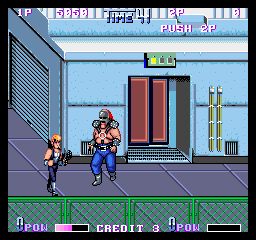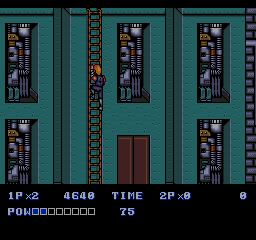Retro Replay Review
Gameplay
Double Dragon II: The Revenge refines the coin-op brawling formula introduced in the first game, trading the traditional punch and kick buttons for a more context-sensitive, direction-oriented attack system. This approach, reminiscent of Technos’ earlier hit Renegade, allows Billy and Jimmy Lee to deliver upward chops, sweeping low kicks, and powerful throws simply by combining joystick inputs with the attack button. The result is a fluid, versatile combat experience that rewards positioning and timing as much as brute force.
(HEY YOU!! We hope you enjoy! We try not to run ads. So basically, this is a very expensive hobby running this site. Please consider joining us for updates, forums, and more. Network w/ us to make some cash or friends while retro gaming, and you can win some free retro games for posting. Okay, carry on 👍)
Arcade veterans will appreciate the fresh array of special moves added in this sequel: lightning-fast elbows, running uppercuts, and even a headbutt can be executed with the right directional input. Enemies are more varied and aggressive than before, weaving through hazards like spiked pits and swinging axes to pummel your health bar. Boss encounters demand both quick reflexes and pattern recognition, as each gang leader has unique counters and weak points to exploit.
Transitioning to the NES, Technos didn’t simply port the arcade game—they expanded it. New stages—such as a dank sewer and a wrecked ship—bring fresh challenges, while illustrated cut-scenes punctuate key moments in the story. Crucially for home play, 2-Player Co-Op is supported with an option to disable friendly fire. This tweak transforms the experience, letting you and a friend strategize in perfect harmony without the frustration of accidental hits.
Graphics
In the arcade, Double Dragon II ramps up its visual appeal with richly detailed character sprites and multilayered backgrounds. Environments shift from neon-lit city streets to grimy docks, each stage populated by unique set-pieces—barrels that explode, swinging pendulums, and collapsing platforms—that feel both interactive and cinematic. Enemy designs range from street thugs in leather jackets to burly martial artists, each animated with smooth walk cycles and reaction frames when struck.
The NES port, while constrained by the console’s color palette and sprite limits, still shines with its own artistic flair. Levels are more expansive, with side-scrolling segments that stretch beyond the arcade’s static screens. Illustrated story panels between levels showcase expressive character art, giving players a visual reward for their progress. Despite occasional flicker when too many sprites crowd the screen, the game maintains a crisp presentation and clear hitboxes.
Audio design complements the visuals perfectly: punchy sound effects deliver satisfying impact, while the soundtrack pulses with energetic chiptune anthems. The arcade’s richer sound hardware offers deeper bass and more varied percussion, but the NES’s upbeat melodies have a nostalgic charm all their own. Both versions punctuate boss entrances with dramatic stings, heightening the sense of showdown each time you face a gang lieutenant.
Story
Double Dragon II wastes no time setting the stakes: in a brutal act of vengeance, the Black Warriors gang has murdered Marian, the Lee brothers’ love interest and sister. Players who remember the first Double Dragon will recall how Billy and Jimmy rescued her from the same thugs—now, driven by grief and righteous fury, they must embark on one final mission to avenge her death.
The arcade narrative is lean but effective, unfolding between stages through short text interludes and boss taunts. There’s a relentless forward momentum as you fight through warehouses, factories, and shipyards, each locale bringing you one step closer to the heart of the Black Warriors. The NES version elaborates further, inserting illustrated cut-scenes that depict Marian’s fate, the Lee brothers’ resolve, and even the final confrontation in dramatic storyboard panels.
While the story doesn’t reinvent the beat ’em-up wheel, its simple revenge plot provides a potent emotional core. Each level’s end boss feels like a personal gauntlet, their exaggerated voices and taunts fueling your desire to press on. For retro enthusiasts, the tale of loss and retribution is a classic arcade trope that still resonates—especially when you’re sending foe after foe flying off the screen.
Overall Experience
Double Dragon II: The Revenge is a hallmark of the golden age of beat ’em-ups, marrying tight controls with memorable stage design and a pulsing soundtrack. Whether you’re jamming quarters into an arcade cabinet or booting up the NES at home, the game delivers a visceral thrill with every successful combo and dramatic boss finish. The shift to a direction-based attack system breathes new life into familiar combat, making every encounter feel fresh.
On the NES, new moves, stages, and cut-scenes extend the arcade action into a fuller single-player campaign, while 2-Player Co-Op adds a social dimension that was missing from the first console outing. The option to turn off friendly fire is a thoughtful inclusion, letting you and a friend coordinate attacks without fear of scoring an accidental hit. The result is a cooperative experience that stands up against later genre classics.
For potential buyers, Double Dragon II represents both an accessible entry point for newcomers to retro beat ’em-ups and a rewarding challenge for seasoned veterans. Its straightforward yet deep combat, varied level hazards, and emotional revenge plot ensure that each playthrough remains engaging. Fans of side-scrolling brawlers owe it to themselves to experience this influential sequel—Marian’s memory depends on it.
 Retro Replay Retro Replay gaming reviews, news, emulation, geek stuff and more!
Retro Replay Retro Replay gaming reviews, news, emulation, geek stuff and more!









Reviews
There are no reviews yet.